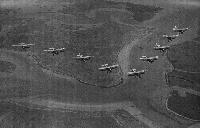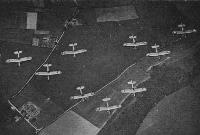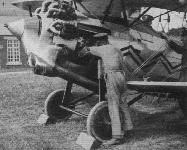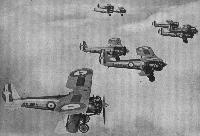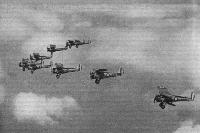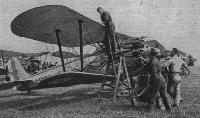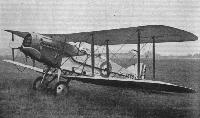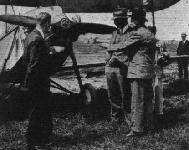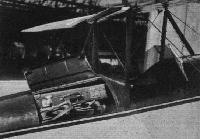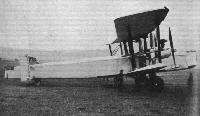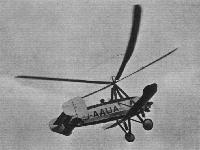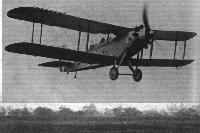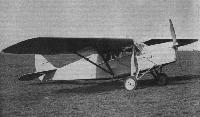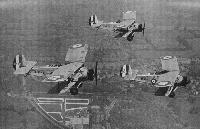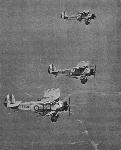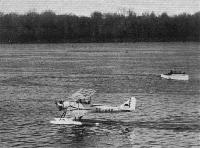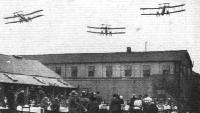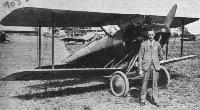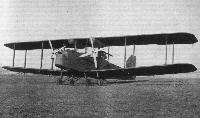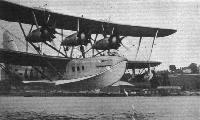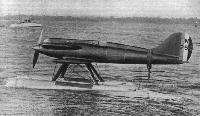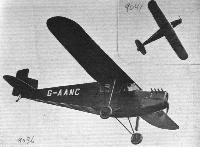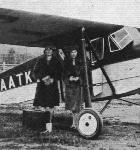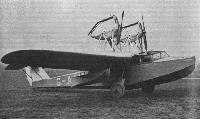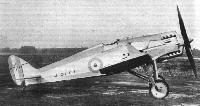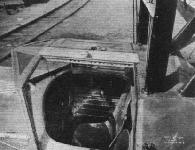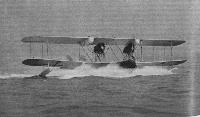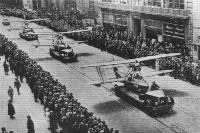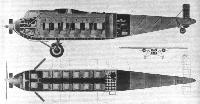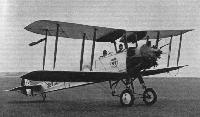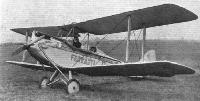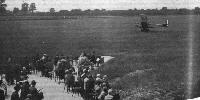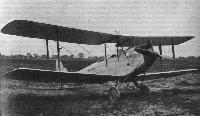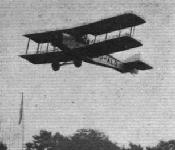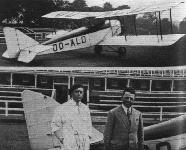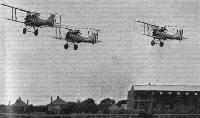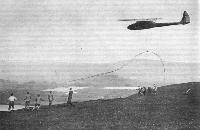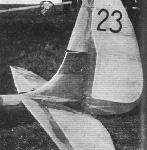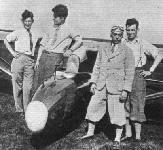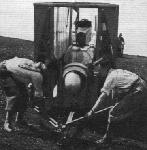Фотографии
-
Регистрационный номер: J9940, J9942 No.33 (Bomber) Squadron at Eastchurch aerodrome. This unique photograph shows the squadron drawn up by flights with its full establishment of 12 machines. The type of aeroplane is the Hawker "Hart" with Rolls-Royce "F" type engine, and this is the first squadron to be equipped with this type. "B" Flight is in front, "C" Flight in the centre and "A" Flight in the rear. The officer in white overalls in front of the nearest "Hart" of "A" Flight is Sqdn.-Ldr. J.J.Breen.
Самолёты на фотографии: Hawker Hart - Великобритания - 1928
-
NO. 33 (BOMBER) SQUADRON FLYING IN "SQUADRON V" FORMATION.
Самолёты на фотографии: Hawker Hart - Великобритания - 1928
-
DAY BOMBERS: No. 33 (Bomber) Squadron in Squadron Formation. The Machines are Hawker "Harts" with Rolls-Royce "Kestrel" Engines.
Самолёты на фотографии: Hawker Hart - Великобритания - 1928
-
NO. 33 (BOMBER) SQUADRON FLYING IN "SQUADRON FORMATION."
Самолёты на фотографии: Hawker Hart - Великобритания - 1928
-
AIRCRAFTMAN WORKING ON A JUPITER.
Самолёты на фотографии: Bristol Bulldog - Великобритания - 1927
-
Регистрационный номер: K1081, K1085 NO. 17 (FIGHTER) SQUADRON! FLYING IN "SQUADRON FORMATION." THIS UNIQUE PHOTOGRAPH SHOWS DETAILS OF THE BULLDOG AEROPLANE. AS WELL AS A GENERAL VIEW OF PERFECT FORMATION FLYING.
Самолёты на фотографии: Bristol Bulldog - Великобритания - 1927
-
NO. 17 (FIGHTER) SQUADRON FLYING IN "SQUADRON V" FORMATION.
Самолёты на фотографии: Bristol Bulldog - Великобритания - 1927
-
THE BULLDOGS OF NO. 17 (FIGHTER) SQUADRON.
Самолёты на фотографии: Bristol Bulldog - Великобритания - 1927
-
Регистрационный номер: J9590 FILLING THE TANK OF A BULLDOG.
Самолёты на фотографии: Bristol Bulldog - Великобритания - 1927
-
AT OLD ALRESFORD AERODROME: Bristols of No. 2 A.C. Squadron pegged out.
Самолёты на фотографии: Bristol F.2A/F.2B Fighter - Великобритания - 1916
-
Регистрационный номер: J6689 THE BRISTOL FIGHTER: First produced during the war, the "Brisfit," as it is often called, is now becoming obsolete, although one Squadron is still equipped with it.
Самолёты на фотографии: Bristol F.2A/F.2B Fighter - Великобритания - 1916
-
Регистрационный номер: N247 THE SUPERMARINE-ROLLS ROYCE S.6: Winner of the 1929 Schneider Trophy Contest, and holder of the World's Speed Record, with a speed of 357-7 m.p.h. The engine is a Rolls-Royce "R" engine
Самолёты на фотографии: Supermarine S.5 / S.6 - Великобритания - 1927
-
Регистрационный номер: G-EBUF Capt, Stack aerobating with his usual verve.
Самолёты на фотографии: De Havilland Moth / D.H.60 - Великобритания - 1925
-
AT VINCENNES: Morane-Saulnier machine: The type 230 (230 h.p. Salmson) is shown here, and was flown by Detroyat.
Самолёты на фотографии: Morane-Saulnier MS.230 - Франция - 1929
-
Регистрационный номер: G-AAUO [2] THE ROBINSON "REDWING": Designed by Mr. John Kenworthy and built by the Robinson Aircraft Co., Ltd., this machine is a side-by-side two-seater of wood construction. The engine is an A.B.C "Hornet" of 75 h.p.
Самолёты на фотографии: Robinson Redwing - США - 1930
-
GETTING AWAY: With its light wing loading the "Redwing" has a very good take-off and climb.
Самолёты на фотографии: Robinson Redwing - США - 1930
-
Регистрационный номер: G-AAUO [2] The "Redwing": This view of the nose gives a good idea of the neat engine cowling, the undercarriage, &c.
Самолёты на фотографии: Robinson Redwing - США - 1930
-
The Power Plant: Mr. Dennis (right) pointing out to Lord Ridley (Chairman of A.B.C. Motors) the neat cowling of the A.B.G. "Hornet" on the "Redwing". On the left is Mr. Elliott, who designed the "Hornet."
Самолёты на фотографии: Robinson Redwing - США - 1930
-
The Christening Ceremony: Air Vice-Marshal Sir Sefton Brancker, Director of Civil Aviation, "unveils" the name "Redwing."
Самолёты на фотографии: Robinson Redwing - США - 1930
-
A large luggage locker, with rearward extents on for golf clubs, is a feature of the "Redwing."
Самолёты на фотографии: Robinson Redwing - США - 1930
-
Регистрационный номер: J9131 THE VICKERS TWIN-ENGINED NIGHT BOMBER: This is an entirely new machine with some unusual features. It is of all-metal construction, and powered by two Rolls-Royce "F" engines.
Самолёты на фотографии: Vickers Vanox / Type 150 / 195 / 255 - Великобритания - 1929
-
Регистрационный номер: G-AAUA THE CIERVA "AUTOGIRO": Instead of wings, this machine has a "windmill," which is caused to rotate by the passage of the machine through the air. The machine cannot stall. The engine is a "Genet."
Самолёты на фотографии: Cierva/Avro C.19 - Великобритания - 1929
-
CENTRE OF ATTRACTION: Visitors at Tollerton were especially interested in the D.H. "Puss Moth," with its inverted "Gipsy" engine, and the Autogiro, which took part in the Pageant.
Самолёты на фотографии: Cierva/Avro C.19 - Великобритания - 1929De Havilland Puss Moth / D.H.80 - Великобритания - 1929
-
This is a Dewoitine D 27 Pursuit 'plane (500 Hispano-Suiza) constructed by the Liore & Olivier firm, which was flown by Doret.
Самолёты на фотографии: Dewoitine D.26 / D.27 / D.53 - Франция - 1928
-
THE FAIREY "FIREFLY": An Interceptor Fighter, of all-metal construction and fitted with Rolls-Royce "F" type supercharged engine. The very clean lines show a strong resemblance to other Fairey machines.
Самолёты на фотографии: Fairey Firefly - Великобритания - 1925
-
ROYAL TRANSPORT: The Wapiti used by Prince George is on the right with the escort machines lined up alongside.
Самолёты на фотографии: Fairey Fairey IIIF - Великобритания - 1926Westland Wapiti - Великобритания - 1927
-
ITS FIRST FLIGHT: The Westland "Wapiti" (Bristol "Jupiter VIII"), piloted by Capt. Paget, makes a flight immediately after the christening ceremony.
Самолёты на фотографии: Westland Wapiti - Великобритания - 1927
-
A SERVICE MACHINE AT VINCENNES: The Breguet 270 all-metal military observation 'plane (600 h.p. Hispano-Suiza). Note the abbreviated fuselage and method of carrying the tailplanes.
Самолёты на фотографии: Breguet Br.270 / Br.330 - Франция - 1929
-
AT VINCENNES: The Liore & Olivier, LeO 25, Bn 4, a twin-engined all-metal bomber.
Самолёты на фотографии: Liore et Olivier LeO 25 - Франция - 1928
-
THE AVRO "TRAINER": Designed to supplant the famous Avro-Lynx, this machine is of all-metal construction, and incorporates all possible modern refinements. Supplied either with "Mongoose" or "Lynx" engines.
Самолёты на фотографии: Avro Tutor/Sea Tutor/Prefect / Type 621/646/626 - Великобритания - 1929
-
THE DE HAVILLAND "PUSS MOTH": Of recent production, this little monoplane is already on order in large numbers. The engine is a "Gipsy III."
Самолёты на фотографии: De Havilland Puss Moth / D.H.80 - Великобритания - 1929
-
The "Gipsy Moth" and "Puss Moth" lent by Mr. W. L. Everard to the A.L.Q. for their demonstration.
Самолёты на фотографии: De Havilland Gipsy Moth / Moth X - Великобритания - 1928De Havilland Puss Moth / D.H.80 - Великобритания - 1929
-
Регистрационный номер: G-AADX, G-AAJG, G-ABBH PROGRESS: Three generations of Moths at Haldon. The standard Gipsy Moth (left). The Coupe Moth (right) and Puss Moth (centre).
Самолёты на фотографии: De Havilland Gipsy Moth / Moth X - Великобритания - 1928De Havilland Moth Coupe - Великобритания - 1928De Havilland Puss Moth / D.H.80 - Великобритания - 1929
-
Регистрационный номер: J9537 [3] FILLING THE PETROL TANK OF AN ATLAS.
Самолёты на фотографии: Armstrong Whitworth Atlas / Ajax - Великобритания - 1925
-
Регистрационный номер: J9541 [2], J9548 [2], J9549 [2] Отличительная черта всех военных самолетов Atlas - крюк для приема донесений под фюзеляжем, стреляющий вперед неподвижный пулемет и турель Scarff задней кабине.
A FLIGHT OF NO. 4 (ARMY. CO-OPERATION) SQUADRON. FLYING IN FORMATIONСамолёты на фотографии: Armstrong Whitworth Atlas / Ajax - Великобритания - 1925
-
Регистрационный номер: J9541 [2], J9548 [2], J9549 [2] A FLIGHT OF NO. 4 (ARMY CO-OPERATION) SQUADRON. ATLAS AEROPLANES WITH JAGUAR ENGINES.
Самолёты на фотографии: Armstrong Whitworth Atlas / Ajax - Великобритания - 1925
-
Регистрационный номер: J9537 [3] AN ATLAS OF NO. 4 (A.-C.) SQUADRON PICKING UP A MESSAGE HUNG BETWEEN TWO STICKS
Самолёты на фотографии: Armstrong Whitworth Atlas / Ajax - Великобритания - 1925
-
Регистрационный номер: J9537 [3] THE ARMSTRONG-WHITWORTH "ATLAS": Fitted with Armstrong-Siddeley "Jaguar" engine, this is now the standard Army Co-operation machine.
The classic Flight photograph of Atlas I AC J9537 of No 4 Sqn with message pick-up hook extended. The aircraft’s camera gun may just be seen inboard of the lower wing. Based at Farnborough, this unit received Atlases in October 1929 and retained them until January 1932, when Audaxes superseded them.Самолёты на фотографии: Armstrong Whitworth Atlas / Ajax - Великобритания - 1925
-
CANADIAN ENTERPRISE: A metal Avro Avian (Genet Major) built in Canada. This aircraft has a wide range of utility in Canada, where the prevalence of lakes and other stretches of water make the seaplane much more practical than the landplane for such work as forest fire patrol and so on.
Самолёты на фотографии: Avro Avian / Type 594/616 - Великобритания - 1926
-
Регистрационный номер: CF-AHV ENTERPRISE IN CANADA: An Avro Avian Seaplane (Genet Major) on the Ottawa River.
Самолёты на фотографии: Avro Avian / Type 594/616 - Великобритания - 1926
-
A formation of Victorias which flew over during the afternoon.
Самолёты на фотографии: Vickers Victoria - Великобритания - 1922
-
A DIFFICULT COLOUR SCHEME: The Blackburn Lincock-Lynx is painted in black and lemon stripes, which do not photograph well. Captain Blake's demonstration of aerobatics on this machine was a very wonderful spectacle.
Самолёты на фотографии: Blackburn Lincock / F.2 - Великобритания - 1928
-
THE BLACKBURN "LINCOCK": As a machine for advanced training, this little single-seater would be difficult to improve upon. It is extremely manoeuvrable. The engine is a "Lynx."
Самолёты на фотографии: Blackburn Lincock / F.2 - Великобритания - 1928
-
FLYING AT EIGHTY-NINE: On May 29 one of the youngest old ladies in Yorkshire took her first flight at the remarkable age of 89! Mrs. Hartly, the old lady concerned (shown here), is great-aunt to the Blackburn brothers, Robert, Norman and Charles. She flew with Capt. Norman Blackburn in a "Bluebird" and thoroughly enjoyed it.
Самолёты на фотографии: Blackburn Bluebird / L.1 - Великобритания - 1924
-
ANOTHER COMMERCIAL MACHINE AT VINCENNES: The Bleriot 111, a low-wing transport monoplane with a 230 h.p. "Titan."
Самолёты на фотографии: Bleriot Bleriot-111 - Франция - 1929
-
The Bleriot Spad G2 training or tourist two-seater, fitted with a 230 h.p. Salmson. (???)
Самолёты на фотографии: Bleriot-SPAD S.91 - Франция - 1927
-
THE HANDLEY PAGE "HYDERABAD": A twin-engined Night Bomber with Napier "Lion" engines. It should be noted that machines of this class are painted a dark colour to render them less conspicuous at night.
Самолёты на фотографии: Handley Page Hyderabad/H.P.24 / Hinaidi/H.P.33 / Clive/H.P.35 - Великобритания - 1923
-
Регистрационный номер: G-AATZ NEARLY ALL IN: The photographer did not quite succeed in catching the whole of this new Short "Calcutta." This is the machine, recently delivered to Imperial Airways. The three engines are Bristol "Jupiters"
G-AATZ over the Medway at Rochester.Самолёты на фотографии: Short Calcutta / Rangoon / S.8 - Великобритания - 1928
-
AT VINCENNES: Morane-Saulnier machine: Another training machine, type 181, with a 60 h.p. Salmson.
Самолёты на фотографии: Morane-Saulnier MS.180 - Франция - 1928
-
Регистрационный номер: N250 THE GLOSTER-NAPIER VI: Designed for last year's Schneider Trophy Contest. Is now being re-conditioned and will be flown a good deal in the near future. Napier Racing engine.
Самолёты на фотографии: Gloster VI Golden Arrow - Великобритания - 1929
-
A FLIGHT OF FAIREY IIIF AEROPLANES: Note that the leading machine has its flaps down, and that as a result the fuselage is at a small negative angle.
Самолёты на фотографии: Fairey Fairey IIIF - Великобритания - 1926
-
Регистрационный номер: S1320 THE FAIREY III F.: In addition to its use as a Day Bomber, the III F. is produced as a General Purpose aircraft, and as a twin-float seaplane with many functions. The engine is a Napier "Lion."
Самолёты на фотографии: Fairey Fairey IIIF - Великобритания - 1926
-
Регистрационный номер: F-AJIG COMMERCIAL MACHINES AT VINCENNES: The Farman F 300 "Silver Star" 8-passenger monoplane with three 230 h.p. "Titans."
Самолёты на фотографии: Farman F.300 - Франция - 1929
-
Регистрационный номер: G-AANC FINISHED FLYING: Flight-Lieut. Schofield's demonstrations of aerobatic flying are always characterised by a remarkable "finish." He is here seen flying the Desoutter-Hermes monoplane, and, inset, flying upside down.
The NFS Desoutters were used for taxi work, here Flt Lt Schofield brings in G-AANC at Woodley on Whit Monday, 9.6.30.Самолёты на фотографии: Koolhoven FK-41 - Нидерланды - 1928
-
Регистрационный номер: G-AATK Miss Winifred Spooner with Lady Currie just before their trip to Paris in the Hermes-Desoutter.
Самолёты на фотографии: Koolhoven FK-41 - Нидерланды - 1928
-
MUNICIPAL INTEREST: The Lord Mayor of Nottingham (Coun. W. Wesson), centre, about to go for a flight in the Desoutter-Hermes limousine piloted by Flight-Lieut. Schofield, right; Mr. Hooley (Sheriff) is on the left.
Самолёты на фотографии: Koolhoven FK-41 - Нидерланды - 1928
-
Регистрационный номер: G-AAZI, HM507 THE NEW DESOUTTER MONOPLANE: The Mark II, with Gipsy III engine, has now been flown at Croydon, and appears to come well up to expectations. The clean nose produced by the inverted engine adds greatly to the appearance of the machine, as does also the new style of tail and slightly shallower fuselage. The new machine is likely to become very popular at the price for which it is to be marketed.
Самолёты на фотографии: Koolhoven FK-41 - Нидерланды - 1928
-
Регистрационный номер: G-AAIP THE FIRST PRIVATELY-OWNED "CUTTY SARK": Mr. Norman Holden has the distinction of being the first private individual to purchase one of the Saunders-Roe "Cutty Sark" Amphibians with "Hermes" engines. Last week he visited Hanworth in his machine, which carries the identification letters G-AAIP.
Самолёты на фотографии: Saunders-Roe Cutty Sark / A.17 - Великобритания - 1929
-
Регистрационный номер: J9771 [2] The D.H.77 prototype J-9771 as shown in the New Type Park at the 1930 R.A.F. Air Pageant at Hendon, with the original Napier E.95 Rapier Srs. I.
Самолёты на фотографии: De Havilland D.H.77 - Великобритания - 1929
-
Регистрационный номер: J9771 [2] Самолёты на фотографии: De Havilland D.H.77 - Великобритания - 1929
-
Регистрационный номер: I-AAVF THE ROMEO Ro.5: With the 85-h.p. Fiat engine, the Romeo has a top speed of 105 m.p.h. It will shortly be manufactured under licence in this country.
Самолёты на фотографии: IMAM(Meridionali) Ro.5 - Италия - 1929
-
CANADIAN VICKERS "VEDETTE MARK VI": A metal-hull flying-boat, that shown being for photographic work; a commercial model for passengers and freight is also produced.
Самолёты на фотографии: Canadian Vickers Vedette - Канада - 1924
-
The pilot's cockpit in the "Vedette Mk. VI" (Photographic model).
Самолёты на фотографии: Canadian Vickers Vedette - Канада - 1924
-
THE SUPERMARINE "SOUTHAMPTON": This type of flying-boat, fitted with Napier "Lion" engines, is used extensively for Coast Defence. The type also has some very long cruises to its credit, such as from England to and around Australia and on to Singapore.
Самолёты на фотографии: Supermarine Southampton / Solent - Великобритания - 1925
-
AT VINCENNES: Morane-Saulnier machine: The type 300 two-seater (tandem) training 'bus fitted with a 95 h.p. Salmson.
Самолёты на фотографии: Morane-Saulnier MS.300 / MS.315 / MS.317 - Франция - 1930
-
AERIAL POLICE: As previously reported in "Flight," New York Police have been equipped with a number of Savoia S-56 amphibian flying-boats for aerial patrol work. These are seen here taking part in a procession through New York City, mounted on special General Motor lorries.
Самолёты на фотографии: Savoia-Marchetti / SIAI S.56 - Италия - 1924
-
"SEAGULLS" IN TASMANIA: Our picture shows a fleet of Supermarine Napier ("Lion") "Seagull" amphibian flying-boats of the Royal Australian Air Force flying above Hobart, Tasmania, and gives some idea of the country which these machines have to fly over.
Самолёты на фотографии: Supermarine Seal / Seagull - Великобритания - 1921
-
THE VICKERS "VIASTRA": These sketches give some idea of the passenger accommodation, &c. The machine will be of all-metal construction, including the covering of wing and fuselage.
Самолёты на фотографии: Vickers Viastra / Type 160 - Великобритания - 1930
-
Регистрационный номер: J8738 THE AVRO-LYNX: One of the variations on the famous old "504," this machine has been the standard training machine of the R.A.F. for many years. The engine is a "Lynx."
Самолёты на фотографии: Avro Avro 504N - Великобритания - 1920
-
Регистрационный номер: G-AAFI A FLYING BUSINESS MANAGER: Mr. F. L. N. St. Barbe, of the De Havilland Aircraft Co., is likely to be a frequent visitor to the various meetings this summer in his new Gipsy-Moth single-seater. The machine is easily identified by its yellow fuselage and the registration letters G-AAFI.
Самолёты на фотографии: De Havilland Gipsy Moth / Moth X - Великобритания - 1928
-
A RADIO RESEARCH MACHINE: Mr. Vincent de Ferranti leaving the Hollinwood works of his firm in their D.H. Moth (Gipsy).
Самолёты на фотографии: De Havilland Gipsy Moth / Moth X - Великобритания - 1928
-
FLYING EXTRAORDINARY: Flight Lieut. Armour giving an exhibition of crazy flying one wheel on the ground, and a wing tip dragging through the grass.
Самолёты на фотографии: De Havilland Gipsy Moth / Moth X - Великобритания - 1928
-
THE DE HAVILLAND "MOTH": Used for various purposes by the R.A.F., the "Moth," in its service versions, is fitted variously with the D.H. "Gipsy" and the Siddeley "Genet" engines.
Самолёты на фотографии: De Havilland Gipsy Moth / Moth X - Великобритания - 1928
-
Регистрационный номер: F-AJLQ AT VINCENNES: The machine is the familiar "Moth" (with "Gipsy" engine), for which the Morane-Saulnier firm has acquired the French rights.
Самолёты на фотографии: De Havilland Gipsy Moth / Moth X - Великобритания - 1928
-
Регистрационный номер: D-1561 SUPER STREAMLINING! The Darmstadt D.18, shown here, built by the Academische Flieger Gruppe at Darmstadt to the designs of Herr Fetcher has a Genet Major engine and has broken quite a considerable number of records. It is credited with a top speed of over 130 m.p.h.
Самолёты на фотографии: Darmstadt D-18 - Германия - 1929
-
Регистрационный номер: G-AAWK GROUND SPEED 10 m.p.h.: Mr. Dudley Watt giving a demonstration of slow flying at Reading on his D.W.2-Cirrus.
Самолёты на фотографии: Dudley Watt D.W.2 - Великобритания - 1930
-
The Dewoitine D35, a 4-passenger transport monoplane, equipped with a 300 h.p. Wright-Hispano.
Самолёты на фотографии: Dewoitine D.35 - Франция - 1931
-
Регистрационный номер: OO-ALD [2] Самолёты на фотографии: Bulte RB.1 - Бельгия - 1928
-
Регистрационный номер: OO-ALD [2] A BELGIAN TRAINING MACHINE: The Bulte two-seater,which is marketed in this country by Sealandair, of 142, Long Acre, arrived from Belgium last week. Bad weather conditions prolonged the flight, and oil trouble necessitated a landing at the Hurlingham Polo Ground. The machine took off again without difficulty. The crew were Adjutant Lang and Mr. Gray (in white).
Самолёты на фотографии: Bulte RB.1 - Бельгия - 1928
-
Mr. Lampich Arpad and his Hungarian Lampich-Thorockay Monoplane (18-h.p. 3-cyl. engine) on which he established a record of 12 hrs. 34 mins. and 1,033-4 kms. (Matyasfold to Monor, Budapest) on June 14
Самолёты на фотографии: Lampich L-1 Mama Kedvence / L-2 Roma - Венгрия - 1924
-
Регистрационный номер: G-AAYV The "Avian Monoplane" with "Genet Major" engine has been designed as a sports version of the standard "Avian." Note the very beautiful lines.
Самолёты на фотографии: Avro Avian Monoplane / Type 625 - Великобритания - 1930
-
THE SERVICE SIDE: Three Gloster "Gamecocks" of No. 23 Squadron gave a fine display of Aerobatics.
Самолёты на фотографии: Gloster Gamecock - Великобритания - 1925
-
THE GLOSTER "GAMECOCK": For many years this type has been in use by R.A.F. Fighter Squadrons. It is still very popular for demonstrations and practising "Aerobatics." The engine is a "Jupiter."
Самолёты на фотографии: Gloster Gamecock - Великобритания - 1925
-
A side view of the crate, ready for towing.
Самолёты на фотографии: Lippisch / RRG Wien - Германия - 1929
-
The "Wien" being assembled at Firle.
Самолёты на фотографии: Lippisch / RRG Wien - Германия - 1929
-
BEAUTY: Two views of the Wien when in the air. The unpigmented dope used makes the wings almost transparent.
Самолёты на фотографии: Lippisch / RRG Wien - Германия - 1929
-
WELL AWAY: The "Wien" just after being launched. The double cord which is used can be seen.
Самолёты на фотографии: Lippisch / RRG Wien - Германия - 1929
-
DETAIL: The careful fairing of the rudder can be seen by the celluloid strip which covers the gap at the post.
Самолёты на фотографии: Lippisch / RRG Wien - Германия - 1929
-
THE VISITORS: Herr Kronfeld has on his right his two friends Herren Flinsch and Ball and on his left is his mechanic Herr Pruhn
Самолёты на фотографии: Lippisch / RRG Wien - Германия - 1929
-
The front end of the "Wien's" travelling crate.
Самолёты на фотографии: Lippisch / RRG Wien - Германия - 1929
-
A GENTLE ONE: The Wien just landing. Herr Kronfeld's landings would not break the proverbial box of eggs.
Самолёты на фотографии: Lippisch / RRG Wien - Германия - 1929
Статьи
- Flight

